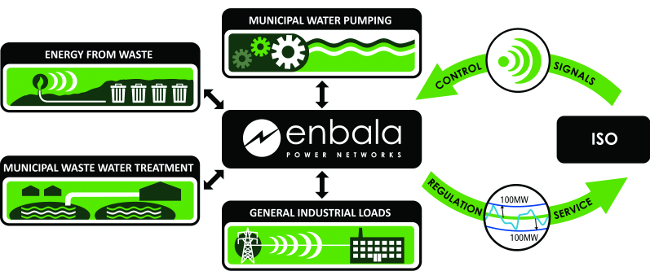ENBALA’s technology harnesses energy and opens new revenue streams for water plants.
It seems impossible, but with its new smart grid development, ENBALA Power Networks is promising municipalities a no-strings-attached source of revenue. We’re not taking full advantage of the flexibility in our power systems, says Ron Dizy, president and CEO of ENBALA. And wasted power is wasted money.
Formerly called Sempa Power, the originally British Columbia-based company’s heritage started with hybrid heating, a system designed to allow commercial buildings to decrease greenhouse gas (GHG) emissions and reduce energy costs through automatically switching between fossil fuels and, in British Columbia, hydroelectricity, based on the cheapest fuel source in a 24-hour cycle. “We’ve always been about optimizing the ay loads use energy,” says Dizy. Sempa’s team wanted to know what else it could do to balance energy.
What does this have to do with water?
Now located in Ontario, the newly renamed ENBALA Power Networks is connecting its smart grid technology to water and wastewater systems. Using two-way communication networks to help the electricity market connect to these facilities, the technology adjusts the way equipment, such as blowers and large pumps, uses energy on a second-by-second basis.
“Based on the water system’s capacity and inherent flexibility, adjusting real-time electricity usage is achievable without affecting water treatment or the delivery of water to the end-user,” Dizy explains. This flexibility, also known as system regulation, is one of the ancillary services required by Ontario’s Independent Electricity System Operator (IESO). Municipalities can sell system regulation back to the IESO— all while reducing the need for fossil fuel generation.
Why water? “The core technology could be applied to anything,” says Dizy. “We look for places that are large users— cold storage facilities, industrial ventilation—or creators of electricity, such as landfill gas. We went after water first because it’s one of the biggest consumers of energy.”
The City of Windsor, Ontario has signed on to become one of the first municipal participants to test the technology, and the Ontario Clean Water Agency (OCWA) is also a partner. OCWA’s first collaboration with ENBALA will be a pilot project to demonstrate capacity for water systems to provide demand-based ancillary services to the IESO.
“This technology helps to free up hydro generators, allowing them to run more often and place more energy into the grid,” says Nick Reid, OCWA’s VP of business development. “We’re also trying to do the right thing for our clients—helping to introduce a new revenue stream by leveraging their existing assets in a new way.”
By helping consumers use an existing system in a smarter, more efficient way, ENBALA is offering them a low-to-no-cost way of lowing GHG emissions and, at the same time, seeing very real economic benefits. — Kerry Freek

